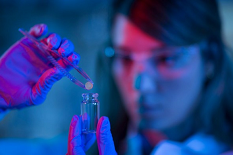News Story
Tuan Reveals Artificial Joint; Could Stave Off Hip Replacements

A hip fracture can ruin a person’s quality of life, especially the active middle-aged and the elderly. A joint replacement is not only a major procedure, but also very expensive.
But Chinese University vice chancellor and president Dr Rocky Tuan Sung-chi believes he and his team could soon change that – they have invented an artificial joint that Tuan says can add years of quality life, and perhaps postpone hip replacements by 10 to 15 years, while costing just US$100 to make.
Tuan, a professor of tissue engineering and regenerative medicine, explained how he led a team at the University of Pittsburgh in the United States, where he worked before taking up his current job, to produce the “microjoint” – a squashy, bendy implant that can be used in place of a natural joint. A prototype is now being tested on a dog following successful experiments on a miniature pig. Tuan believes human trials are three to four years away.
The US space agency Nasa has taken an interest in the project, and plans to send the man-made joint to the International Space Station to test why astronauts lose bone density during long periods in orbit.
Tuan said the microjoint, if used in humans, would buy time before a full joint replacement became necessary when treating osteoarthritis, the primary cause of disability that afflicts more than 20 million people a year in the US alone. The degenerative bone disease affects about 7 per cent of men and 13 per cent of women aged over 50 in Hong Kong.
Tuan said he was motivated by the need to find which of the four joint main tissues caused osteoarthritis. “We don’t know where it starts and if more than one tissue is involved,” he said. “So we decided to divide and conquer.”
Tuan and his team reconstructed the tissues using cells in a bioreactor. Then, he said, he created a method “where I can encapsulate the cells within the artificial material I produced”.
That material can be used to make “biodegradable, body-friendly solids, on the scale of microns [millionths of a metre]”.
The microjoint looks like a blob but “it is actually a joint”, Tuan said. “It doesn’t look like a joint but physiologically it behaves like one”.
"We are now making the bone/cartilage constructs to be flown to the International Space Station"
Rocky Tuan, CECT Collaborator
Tuan said Nasa particularly liked the idea of “reproducing tissue on a very small scale”.
“We are now making the bone/cartilage constructs to be flown to the International Space Station,” Tuan said. Once there, they will be used to study why astronauts lose their bone density in space.
The artificial joints sent into space would have internal electronics to monitor and log changes in their own shape. The researchers could analyse those logs to better understand the density loss.
“With the Nasa experiments, we have to demonstrate that not only can we produce the joint but that we can do so in an environment that is suitable for shipping to the space station,” Tuan said.
He is enthusiastic about the potential of the microjoint to improve quality of life.
“Total joint replacement, in terms of [the] total happiness index, is the best procedure ever. However, the challenge is that it only lasts 10 to 15 years. If you are 65 or 70 that’s fine,” he said.
But if a patient needed a total replacement at age 40, they could need another replacement in their twilight years, with all the risks entailed.
The microjoint, Tuan said, was aimed at buying “another 10 to 15 years for you if your knee or hip is falling apart”.
“If I can get another 10 to 15 years for you so that you can delay the total joint replacement by 15 years that’s already a huge [success].”
Read more at: http://www.scmp.com/news/hong-kong/health-environment/article/2140485/hong-kong-academic-reveals-squashy-artificial
Published April 6, 2018

















